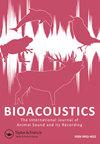Complex acoustic signals in Crossodactylodes (Leptodactylidae, Paratelmatobiinae): a frog genus historically regarded as voiceless
IF 2.1
4区 生物学
Q2 ZOOLOGY
Bioacoustics-The International Journal of Animal Sound and Its Recording
Pub Date : 2021-04-07
DOI:10.1080/09524622.2021.1904443
引用次数: 3
Abstract
ABSTRACT Vocal sounds occur in most anurans and are often emitted as simple and stereotyped acoustic signals. Some frog groups, however, have complex signals and others can produce distinctive acoustic structures, such as purely ultrasonic calls. Crossodactylodes is a genus of bromeligenous frogs that is understudied in many aspects. This genus has been historically regarded as voiceless, but recent studies reported briefly on vocal sounds in two species. Here, we provide the first quantitative description of vocalisations of Crossodactylodes frogs and describe the vocal repertoires of three species. Vocalisations are formed of up to three call types, reported herein as creaking, chirp and squeak calls. We discuss the major call patterns and the repertoire of Crossodactylodes. We also discuss the evolutionary and functional implications of the low-intensity calls produced at the water–air interface inside bromeliads. The absence of some morphological structures normally involved in sound reception (elements of the middle ear) in Crossodactylodes frogs indicates that extratympanic pathways might be the main auditory route in these highly specialised leptodactylids.交叉趾蛙属(细趾蛙科,副趾蛙科)的复杂声信号:一个历史上被认为是不发声的蛙属
大多数无尾动物都会发出声音,通常是简单而刻板的声音信号。然而,一些蛙类有复杂的信号,而另一些蛙类可以产生独特的声音结构,比如纯粹的超声波叫声。交叉趾蛙是凤梨源蛙的一个属,在许多方面都没有得到充分的研究。这个属在历史上被认为是不发声的,但最近的研究简要报道了两个物种的发声。在这里,我们提供了交叉趾蛙发声的第一个定量描述,并描述了三个物种的发声能力。发声由多达三种呼叫类型组成,本文报道为吱吱声,唧唧声和吱吱声。我们讨论了主要的呼叫模式和曲目的交叉趾。我们还讨论了凤梨属植物在水-空气界面产生的低强度叫声的进化和功能意义。交叉趾趾蛙缺少一些通常与声音接收有关的形态学结构(中耳元件),这表明在这些高度特化的掌趾趾蛙中,鼓室外通路可能是主要的听觉途径。
本文章由计算机程序翻译,如有差异,请以英文原文为准。
求助全文
约1分钟内获得全文
求助全文
来源期刊
CiteScore
4.50
自引率
0.00%
发文量
25
审稿时长
>12 weeks
期刊介绍:
Bioacoustics primarily publishes high-quality original research papers and reviews on sound communication in birds, mammals, amphibians, reptiles, fish, insects and other invertebrates, including the following topics :
-Communication and related behaviour-
Sound production-
Hearing-
Ontogeny and learning-
Bioacoustics in taxonomy and systematics-
Impacts of noise-
Bioacoustics in environmental monitoring-
Identification techniques and applications-
Recording and analysis-
Equipment and techniques-
Ultrasound and infrasound-
Underwater sound-
Bioacoustical sound structures, patterns, variation and repertoires

 求助内容:
求助内容: 应助结果提醒方式:
应助结果提醒方式:


